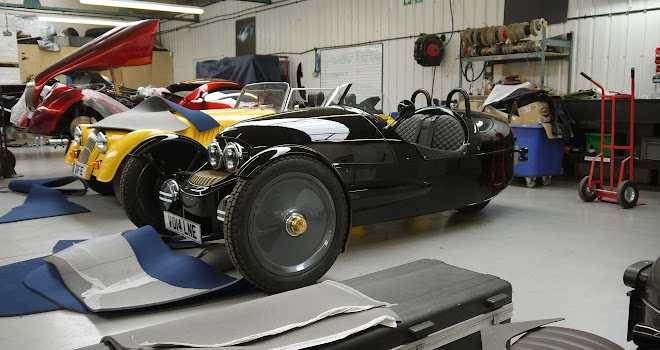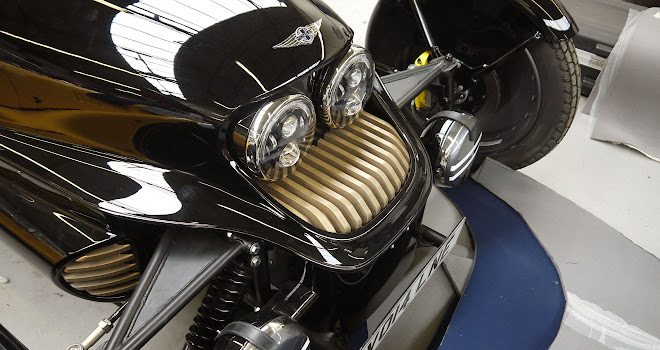“Everything’s old and new here,” says Jon Wells, head of design at the Morgan Motor Company. As if to prove his point, we pass a modern 3D printer nestling in the same workshop as a gigantic curved wooden vice that looks as if it fell off the ark.
The old tool is still in daily use, coercing plywood into shape for wheel-arch frames. The curve hasn’t changed since 1935 and fiddling with it “would be like killing a grandparent”, Wells adds.

Morgan’s upcoming EV3 electric car is both new and old too. It’s based on a petrol-powered 3 Wheeler that’s only been on sale since 2011, but which was designed to resemble Morgan products from about 80 years earlier.
With no need for a V-twin engine at the front, Wells has given the battery powered EV3 a curvy new nose. But not too new – it was inspired by 1930s racing cars, from an era when automotive streamlining and aerodynamics were being grappled with for the first time.

The EV3 design also features high-tech carbon fibre and aluminium bodywork supported by a low-tech wooden frame. Underneath is a steel chassis cradling the latest in lithium-ion battery technology.
It’s clear that the pattern of mixing old and new runs through the EV3 like the grain in its ash frame.
And while it may seem like an old fashioned material, Wells leaps to the defence of wood as an entirely valid 21st century choice. “It’s sustainable, it’s quick to work with, it’s not dependent on having heavy tooling,” he notes, adding that it dampens both sound and vibration and absorbs handy amounts of energy in an impact.

All current Morgans are hand-built in Britain with wooden body frames, skinned in aluminium, over a steel or aluminium chassis. The vast majority of Morgans have been kept and cherished for generations.
As a result, Wells argues, even the most hairy chested Morgans, powered by 4.8-litre BMW V8s, ought to be considered green. “These cars aren’t put back into the ground, and end of life is probably the most damaging part of a car’s lifecycle. So when you consider the lifespan, the fact they’re made with completely low-energy manufacture – everyone’s using their hands, there’s no big-energy manufacturing. And we’re using locally sourced sustainable material. When you consider those, what comes out of the tailpipe is actually less of a consideration.”
Nonetheless, even Morgan has to think about fleet-average CO2. Hence the EV3 and a yet-to-be-unveiled hybrid, funded in part by a government grant.

Wells’ EV3 design made its debut last spring, at the Geneva motor show. “It was a great success at Geneva and I think that’s because it is still very much a Morgan,” Wells says. “It hasn’t lost its identity and become a commuter vehicle that’s easy to use and soulless. It’s still very much about driver interaction. You can still power-slide it. It still maintains that coach-built British sports car ethos, but with a different drivetrain.”
The design has evolved since, in part because Morgan has agreed a partnership with retailer Selfridges. The two companies are the same age, having both been founded in 1909. To tie in with the date, a limited edition of 19 specially designed EV3s will be sold through Selfridges, accompanied by accessories created by nine British fashion brands including an Alexander McQueen scarf, Belstaff jacket and driving goggles by Linda Farrow.

Wells says he and the creative director at Selfridges collaborated to redesign the Geneva show car. It is literally the same car, albeit with a new body – the metallic grey fuselage has been lifted off and put to one side in Morgan’s development workshop, replaced with a black body with bronze and yellow details. The new colour scheme chimes neatly with Selfridges branding.
Wells points out that the smaller leather steering wheel and pale wood dashboard are also new, chosen by the Selfridges team.

He is also keen to highlight the new wheels at the front of the latest EV3, replacing the wire wheels seen in Geneva. These are solid metal discs, not flush covers fitted over spokes. “This is something I’ve been wanting to do forever, and the Selfridges budget gave me the opportunity to do it,” Wells admits with glee. Like most Morgan wheels, the discs are centre-splined items, fastened by a big central nut.
The EV3 has also notably gained an extra headlamp. The Geneva concept featured a monocle headlight, offset in its blanked-off grille, supported by a pair of driving lamps at axle height. The Selfridges edition has twin headlamps nestling close together, and what appear to be covers over the driving lamps, secured by leather straps.

That piece of design was inspired by wartime blackout lights, Wells says, which featured narrow slots to let out the bare minimum of illumination. He switches on the EV3 to demonstrate that the round units are not actually driving lamps at all but housings for two strips of LEDs – daylight running lamps above indicators.
Other changes include a vestigial windscreen and passenger-side roll-hoop.

Beyond the Selfridges 19, the EV3 will likely revert to a single headlamp, Wells predicts. “The EV3’s monocle was complete Marmite – some people loved it and some thought it was terrible,” he explains. “But I was all about the monocle. The original concept car had the monocle, a single wing-mirror, the open cockpit on one side and a single roll-hoop. So it had a round geometry on one side and the other was completely clean. Of course the EV3 will be completely bespoke but it will probably come like that as standard – single headlamp, single everything. Second lamps and hoops will be optional.”
The front also features a row of big slotted fins, flanked by two smaller versions, cast in solid brass. While a visual and tactile delight at the front of the car, these are not yet part of the battery cooling system as first envisaged.

“They were designed as functional heatsinks,” Wells notes. “The battery supplier asked for a heatsink on the outside of the car, so we got all carried away with that idea and made this big brass heatsink, when what they were actually after was a small little thing underneath the car.” As a result, the brass teeth of the prototype remain decorative, although Wells still hopes to see them put to proper use by the time of the first customer cars.
Wells is, after all, justifiably proud of the honest way Morgan uses materials. There are no fake finishes here – if something looks like leather or metal it will be made from leather or metal. “It’s working within the constraints of the materials that actually gives the design so much more integrity,” he notes.
Despite its long history and old fashioned appeal, Morgan can still spring the odd surprise, Wells says. “As long as the core elements that people appreciate in Morgans are there, we are confident we can be very flexible and do things that are quite outrageous,” he says. “The EV3 was brave but we knew it would be a Morgan, it would be hand-made here, be a lot of fun to drive, be tailored to the customer’s specification and we knew it would have integrity.”
As noted, Morgan has no problem doing new. As long as it’s old as well.




